归化与异化(英语)
- 格式:pptx
- 大小:303.95 KB
- 文档页数:1
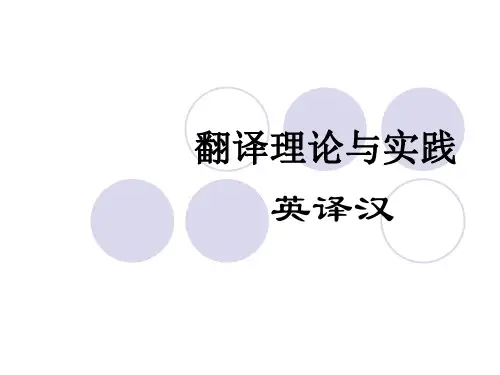
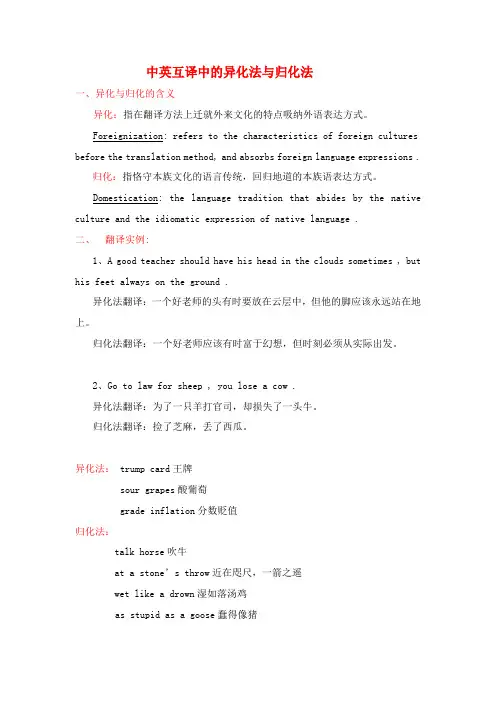
中英互译中的异化法与归化法一、异化与归化的含义异化:指在翻译方法上迁就外来文化的特点吸纳外语表达方式。
Foreignization: refers to the characteristics of foreign cultures before the translation method, and absorbs foreign language expressions .归化:指恪守本族文化的语言传统,回归地道的本族语表达方式。
Domestication: the language tradition that abides by the native culture and the idiomatic expression of native language .二、翻译实例:1、A good teacher should have his head in the clouds sometimes , but his feet always on the ground .异化法翻译:一个好老师的头有时要放在云层中,但他的脚应该永远站在地上。
归化法翻译:一个好老师应该有时富于幻想,但时刻必须从实际出发。
2、Go to law for sheep , you lose a cow .异化法翻译:为了一只羊打官司,却损失了一头牛。
归化法翻译:捡了芝麻,丢了西瓜。
异化法: trump card王牌sour grapes酸葡萄grade inflation分数贬值归化法:talk horse吹牛at a stone’s throw近在咫尺,一箭之遥wet like a drown湿如落汤鸡as stupid as a goose蠢得像猪A big reward will make the brave come forward. 重赏之下,必有勇夫。
Only a headhunter like Bo Le---an ancient Chinese good at headhunting fine steeds---can discover talented people. 有伯乐而后得千里马。

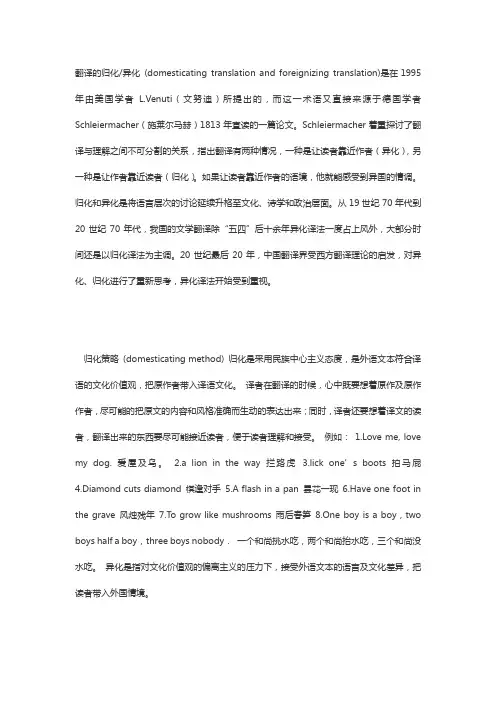
翻译的归化/异化(domesticating translation and foreignizing translation)是在1995年由美国学者L.Venuti(文努迪)所提出的,而这一术语又直接来源于德国学者Schleiermacher(施莱尔马赫)1813年宣读的一篇论文。
Schleiermacher着重探讨了翻译与理解之间不可分割的关系,指出翻译有两种情况,一种是让读者靠近作者(异化),另一种是让作者靠近读者(归化)。
如果让读者靠近作者的语境,他就能感受到异国的情调。
归化和异化是将语言层次的讨论延续升格至文化、诗学和政治层面。
从19世纪70年代到20世纪70年代,我国的文学翻译除“五四”后十余年异化译法一度占上风外,大部分时间还是以归化译法为主调。
20世纪最后20年,中国翻译界受西方翻译理论的启发,对异化、归化进行了重新思考,异化译法开始受到重视。
归化策略(domesticating method) 归化是采用民族中心主义态度,是外语文本符合译语的文化价值观,把原作者带入译语文化。
译者在翻译的时候,心中既要想着原作及原作作者,尽可能的把原文的内容和风格准确而生动的表达出来;同时,译者还要想着译文的读者,翻译出来的东西要尽可能接近读者,便于读者理解和接受。
例如:1.Love me, love my dog. 爱屋及乌。
2.a lion in the way 拦路虎3.lick one’s bo ots 拍马屁4.Diamond cuts diamond 棋逢对手5.A flash in a pan 昙花一现6.Have one foot in the grave 风烛残年7.T o grow like mushrooms 雨后春笋8.One boy is a boy,two boys half a boy,three boys nobody.一个和尚挑水吃,两个和尚抬水吃,三个和尚没水吃。
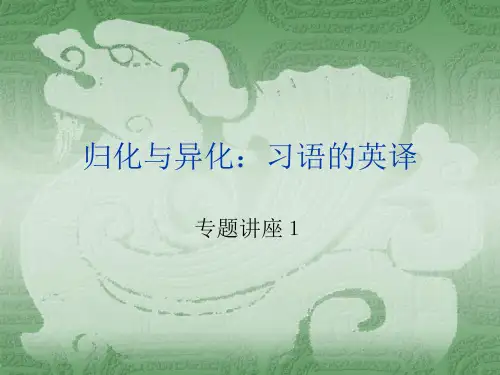
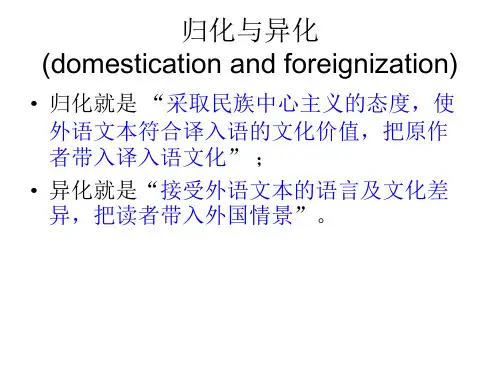
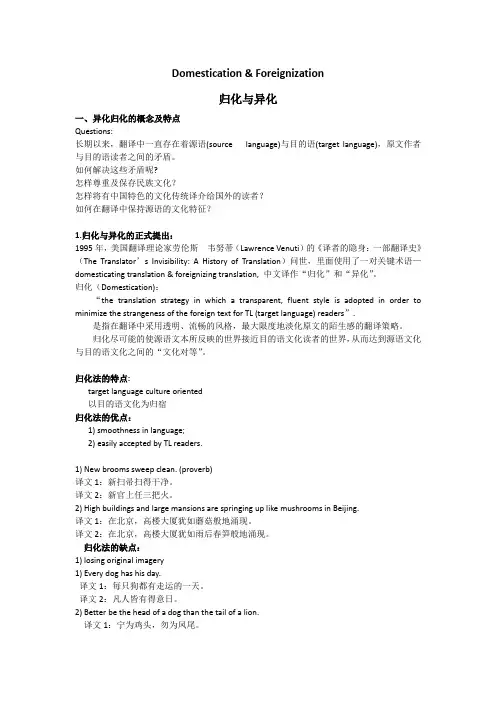
Domestication & Foreignization归化与异化一、异化归化的概念及特点Questions:长期以来,翻译中一直存在着源语(source language)与目的语(target language),原文作者与目的语读者之间的矛盾。
如何解决这些矛盾呢?怎样尊重及保存民族文化?怎样将有中国特色的文化传统译介给国外的读者?如何在翻译中保持源语的文化特征?1.归化与异化的正式提出:1995年,美国翻译理论家劳伦斯韦努蒂(Lawrence Venuti)的《译者的隐身:一部翻译史》(The Translator’s Invisibility: A History of Translation)问世,里面使用了一对关键术语—domesticating translation & foreignizing translation, 中文译作“归化”和“异化”。
归化(Domestication):“the translation strategy in which a transparent, fluent style is adopted in order to minimize the strangeness of the foreign text for TL (target language) readers”.是指在翻译中采用透明、流畅的风格,最大限度地淡化原文的陌生感的翻译策略。
归化尽可能的使源语文本所反映的世界接近目的语文化读者的世界,从而达到源语文化与目的语文化之间的“文化对等”。
归化法的特点:target language culture oriented以目的语文化为归宿归化法的优点:1) smoothness in language;2) easily accepted by TL readers.1) New brooms sweep clean. (proverb)译文1:新扫帚扫得干净。
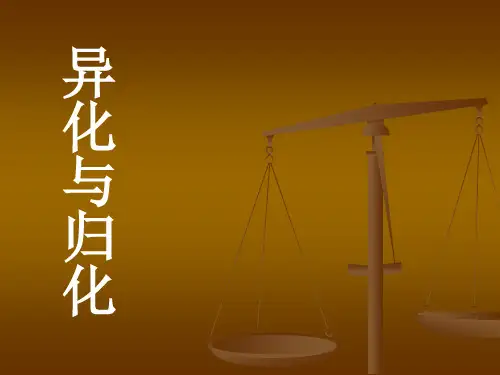
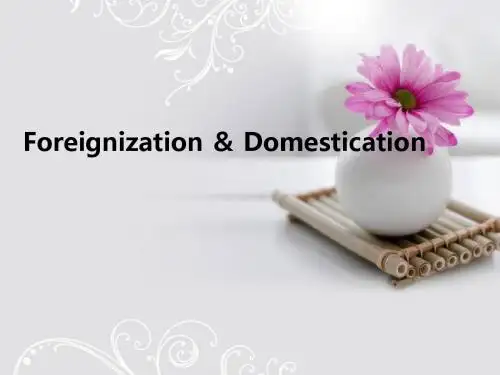
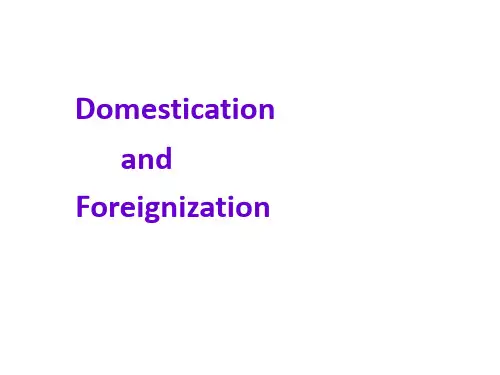
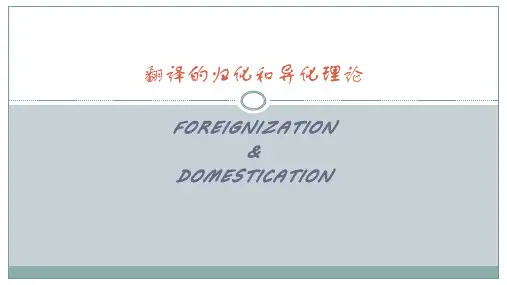
归化异化概述及其使用一、归化异化的涵义及作用归化(domestication)和异化(foreignization)是一种专业的翻译术语,是两种翻译策略称谓,最先由美国的著名翻译学者劳伦斯·韦努蒂(LawrenceVenuti)提出。
按照翻译研究词典(DictionaryofTranslationStudies)中给出的定义,归化是指在文学翻译中译者尽可能将译文本土化,以读者所习惯的方式采用透明、流畅的风格翻译,尽可能减少读者对外语文本的生疏感让读者更好地理解译文的翻译策略,简言之就是译者向读者靠拢;异化则要求译者在翻译中最大限度保留原文的语言特点和表达方式,保留原文的异域性的翻译策略,即要求译者向作者靠拢。
归化与异化两种策略是翻译界如何处理文化差异问题的两种对立意见形成的,归化认为译文应以译文读者为文化归宿,异化则主张应以原作者为文化归宿,两种文化归宿不但表现在语言措辞,更表现在跨文化意义上。
翻译界对于归化和异化的问题,一直以来讨论最为激烈。
其实,从翻译角度看,没有任何译文是完全的归化,也没有任何一个译文属于完全的异化。
译文是译者在翻译过程中将两者相互交融的产物。
非要说区别的话,仅在于他们杂合水准的不同。
文学翻译作为翻译的一种,在翻译历史上有着极其重要的地位。
在文学翻译中,翻译主体的地位、特性和目的都是影响文学翻译的重要因素。
文学翻译中的归化异化我们也能够看作是“直译和意译”两种翻译法的延伸。
以文化为主导的归化异化两种翻译策略在翻译史上都有着各自的积极作用。
“归化”要求翻译时与本土文化结合,这样能够克服语言了解和文化差异上的障碍,更有利于文化交流;“异化”要求翻译更原汁原味,这又能给封闭的文化体系和一些接受水准较低的读者带来新的语言形式,并开拓他们的文化视野。
从单方面讲,归化和异化都有着自身的缺点,过度的归化可能会抹杀原本文学的民族特性,抹杀文学译本的可读性,过度的异化则容易产生沟通障碍,不利于读者理解了解以及对整个篇章的把握。
“归化”与“异化”一、归化与异化归化(domestication)和异化(foreignization)是两种翻译策略。
在翻译研究领域首先将这两个词语作为术语使用的是美国翻译学者韦努蒂(Lawrence Venuti)。
归化是指译者采用透明、流畅的风格以尽可能减少译语读者对外语文本的生疏感的翻译策略;异化则指刻意打破目的语的规范而保留原文的某些异域语言特色的翻译策略。
翻译的归化与异化虽由韦努蒂所提出,而这一术语又直接来源于德国语言学家,翻译理论家施莱尔马赫(Schleiermacher)。
施莱尔马赫在《论翻译的方法》中提出两种翻译途径,即一种是尽可能让作者安居不动,而引导读者去接近作者;另一种是尽可能让读者安居不动,而引导作者去接近读者。
归化翻译指的是一种以目的语为归宿的翻译,即采用目的语文化所认可的表达方式和语言规范,使译文流畅、通顺,以更适合目的语的读者。
奈达是归化翻译的倡导者,他重视翻译的交际功能。
他提倡的“动态对等”(dynamic equivalence),如语义对等,语言对等,和文体对等等,他认为翻译时不求文字表面的死板对应,而要在两种语言间达成功能上的对等。
异化翻译是以源语文化为归宿的翻译,即努力做到尽可能地保持原作的风味,使源语文化的异国情调得以存续,为了使目的语读者能够领略到“原汁原味”而不惜采用不符合目的语的语言规范。
韦努蒂是美国一位解构主义翻译思想积极创导者,他通过对西方翻译史的研究,批判了以往翻译中占主导地位的以目的语为归宿的倾向,并提出了以解构主义思想来反对译文通顺烦人翻译策略。
解构主义的翻译思想,不是要“求同”,而是要“存异”。
二、两译文的比较杨宪益与夫人戴乃迭合译的A Dream of Red Mansions和戴维•霍克斯翻译的The Story of the Stone,是《红楼梦》两个完整的英译本,二者都是公认的成功之作,且各有特色。
下面将以《红楼梦》第三回为例,从语言转化,诗词的翻译,以及文化输出等方面对两译文进行比较。
英汉翻译的方法——直译、意译与归化、异化一.直译与意译:在谈到直译和意译时,人们常常用英文词语literal translation 和freetranslation。
此时人们关心的是语言层面的技术处理问题,即如何在保持原语形式的同时,不让其意义失真;而意译则认为语言有不同的文化内涵和表达形式,当形式成为翻译的障碍时,就要采取意译。
直译和意译之争的靶心是意义和形式的得失问题。
在中国的翻译史上,赞成直译和意译的均有人在,初期佛典翻译中的文质说,唐代玄奘的“求真”与“喻俗”,近代有严复的“信达雅”及鲁迅的“宁信而不顺”与赵景深的“宁顺而不信”等,都是从直译和意译的角度来探讨翻译的原则。
1.直译(literal translation)英、汉语的结构有相同的一面,汉译时可照译,即直译。
直译既忠实原文内容,又符合原文的结构形式。
直译有不少优点,例如能传达原文意义,体现原文风格等。
但是,直译具有一定的局限性。
例如译文有时冗长罗唆,晦涩难懂,有时不能正确传达原文意义,有时甚至事与愿违。
Literal translation is where the forms of the original are retained as much as possible, even if those forms are not the most natural forms to preserve the original meaning.Literal translation is sometimes called word-for-word translation (as opposed to thought-for-thought translation). A more accurate, but less well-known, label for this approach is formal equivalence translation. Because literal translation focuses on forms of language, it sometimes misses some of the meaning of those forms, since meaning is found not only in the forms of individual words, but also in relationships among words, phrases, idiomatic uses of words, and influences of speaker-hearer, cultural, and historical contexts. Words often have different meanings in different contexts, but a literal translation often does not account for these differences. So literal translation often is not the most accurate form of translation.直译的五大误区:①否定句型中的直译误区英语中有一些不同的否定句型,其中有一些句型不能完全采用直译法进行翻译,否则,就会造成误译,甚至与原意背道而驰,下列几种否定句型值得注意:A.部分否定句型,这种句型不同于汉语的思维形式。
Cultural differences in language and translation strategiesAbstract:Because of the different customs and geographical environment, there is a huge cultural difference in English and Chinese. This kind of difference brings to the language communication between the obstacles. Language schools make it possible to different language communication, through domestication and alienation translation strategies, which can realize communication between two languagesKey words: differences; Strategy; Domestication; Alienation; translation一.IntroductionTranslation is not only a kind of cross-language communicative activity, but also a cross-cultural communication activity. Language and culture are inseparable and they can influence each other. Language is the product of culture, no matter from the language symbols or the society, it has an obvious cultural characteristics. Language culture focuses on cultural attribute, the cultural value and cultural function of language, etc. As language connotation of culture, giving is all aspects of the language. The following three aspects are typical expression(1) Impact and strict language systems (including pronunciation,vocabulary, grammar, etc.)(2) Decided the content and form of language(3) Affect human’s language thinking and expression formThus, as a cultural carrier of language is only meaningful in a particular culture. As the American translation theorist Nida said: "translation isthe communication between the two cultures. For truly successful translating, familiar with two cultures is even more important than to master two languages.” there is a huge difference in Chinese-English nationality values, beliefs, customs, historical background, geographical conditions, social system, life experience, etc. This difference not only imprint their respective language but also bring many difficulties for the mutual translation between the two languages. This article start from the cultural differences of Chinese-English, try to seek the cultural equivalence translation by domestication and alienation.二.cultural differences between Chinese-EnglishBecause language is a product of culture and the social, we should understand it from the perspective of cultural and social. Chinese culture emphasize the "value theory" while English advocating "personal value supremacy". Besides values differences, Chinese-English cultural differences there are geographical environment and social environment, climate conditions and customs, etc.(一) cultural differences caused by geographicalenvironmentThere is a regional culture. Special geographical environment and climate characteristics of the skin often give the region culture. Britain is the island, located in the western hemisphere, north temperate zone, oceanic climate, so its language reflect the geographical characteristics. For example: spend money like water; make water; all at sea. While China is located in mainland Asia, Chinese say “spend money like earth”As for the different climate lead to the different culture is also numerous. For example “Dongfeng” in China is the symbol of harvest, while “West Wind” replaces it in west countries.(二) cultural differences caused by CustomsChinese-English cultural differences caused by customs is obvious on animal vocabulary. British culture is the typical "Ma Wenhua", such as talk horse, get on one’s high horse,horse and horse etc. However, Chinese a "NiuWenHua".三.Translation and StrategiesDomestication and alienation into China, many researchers raised their opinions on the two translation strategies. In 1987, an academic paper entitled “Domestication: The Wrong Track in Translation” by Liu Yingkai aroused the first round of dispute on domestication and alienation. In 1995, Weihui Reading Weekly and Foreign Languages School of Nanjing University organized a survey of readers, responses to different versions of the French novel Scarlet and Black, which gave rise to a debate on many translation issues, including domestication and alienation . Domestication and alienation serve as two major translation strategies. The two terms originated from German theologician and philosopher, Friedrich Schleiermacher’s lecture. Later on, Venuti (1995) explained the two terms. According to Venuti, domestication is the dominating translation strategy in Anglo-American culture. Employment of domestication brings the original text and author to the target text readers, erasing the linguistic and cultural differences and making the original text conform to the current dominant linguistic characteristics and values in the target-language culture. Alienation was coined by Venuti to resist domestication. Application of alienation brings the target language readers to the original author and the original text, keeping the original linguistic and cultural differences and even attempting to find differences. We may realize alienation by using non-standarddiscourse or choosing to translate a text that challenges the contemporary canon.Reference:[1]Nida, Eugene A. Language, Culture and Translating. Shanghai Foreign Language Education Press. 1993:105-115.[2]赵爱国.语言文化学论纲[M].黑龙江人民出版社,2006:28-41.屈小楠,李春晓,冉小桃,徐相舒。
异化翻译与归化翻译异化翻译法(或异化法) (foreignizing translation or minoritizing translation) 和归化翻译法(或归化法) ( domesticating translation or domestication) 是美国翻译理论家Lawrence Venuti (1995)创造出来用来描述翻译策略的两个术语。
异化翻译法是故意使译文冲破目的语的常规,保留原文中的异国情调。
Venuti 把异化翻译法归因于19 世纪德国哲学家Schleiermacher 的翻译论说“译者尽量不惊动原作者,让读者向他靠近”( Schleiermacher , 1838P1963 : 47 , 1838P1977 : 74 ;V enuti ,1995 :19) 。
Schleiermacher 本人是赞同采用异化法的。
Venuti (1995 :20) 指出,在盲目自大地使用单语并把归化翻译法作为标准的文化社会(例如英美社会) 中应提倡异化翻译法。
在这种情况下采用异化法是一种对当时的社会状况进行文化干预的策略,因为这是对主导文化心理的一种挑战。
主导文化心理总是尽力压制译文中的异国情调(或“异物”) 。
Venuti 把异化翻译描述成一种“背离民族的压力”(1995 :20) ,其作用是“把外国文本中的语言文化差异注入目的语之中,把读者送到国外去”(1995 :20) 。
具体来说,异化翻译法包括以下特点: (1)不完全遵循目的语语言与语篇规范; (2) 在适当的时候选择不通顺、艰涩难懂的文体; (3) 有意保留源语中的实观材料或采用目的语中的古词语; (4) 目的是为目的语读者提供一次“前所未有的阅读经验”(1995 : 20) 。
不过,Venuti 也承认,译文是由“本土的文化材料”组成的,异化翻译(像归化翻译那样) 只能是翻译过程中的一种策略,所不同的是,采用异化法的译者一般都态度鲜明,而不是隐隐匿匿(1995 :34) 。